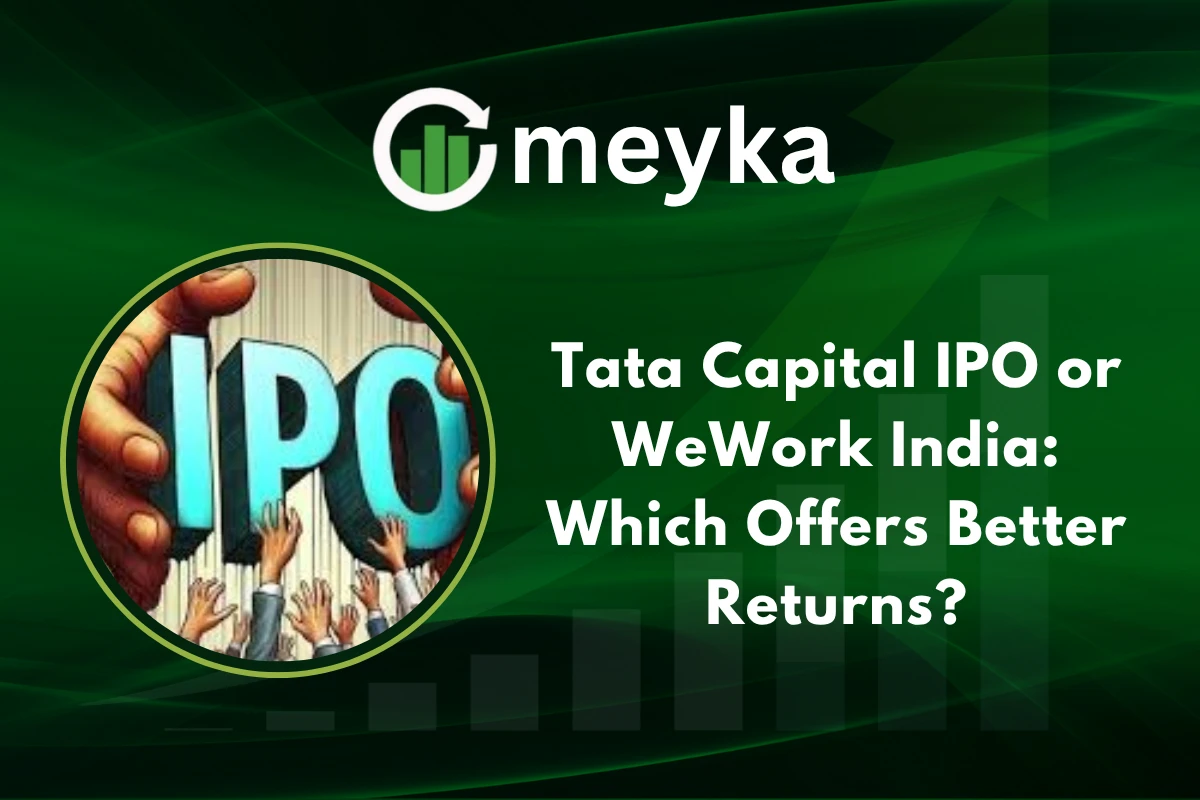Tata Capital IPO or WeWork India: Which Offers Better Returns?
Tata Capital IPO vs WeWork India is the top debate for investors this week. Two major listings arrive in early October 2025. One is a large finance IPO backed by a trusted group. The other is a flexible office player with a global name but mixed market signals.
This article compares both deals simply. It uses price bands, grey market premium, subscription cues, and valuation analysis to judge likely listing gains and longer-term returns.
Tata Capital IPO – India’s Biggest Market Debut This Year
Tata Capital is coming with a Rs 15,511.87 crore book-built IPO. The price band is Rs 310–326 per share. The issue mixes a fresh issue and an offer for sale, and opens on October 6 and closes on October 8, 2025.
At the upper band, a retail lot costs about Rs 14,996. Grey market premium suggests modest listing gains of about 8%.
Why is Tata Capital IPO getting strong investor interest?
Brand trust and scale are major draws. Tata Capital is part of a large group known for governance and wide distribution. The IPO’s size and the fresh capital component make it attractive to institutions that value steady loan books and regulated growth.
That said, the IPO is priced well below recent unlisted trades, which limits immediate upside for some unlisted investors. The Economic Times notes the pricing surprise and the sheer scale of the issue.
WeWork India IPO – Can It Deliver Sustainable Growth?
WeWork India is a smaller Rs 3,000 crore offer for sale, with a price band of Rs 615–648. The IPO opens on October 3 and closes on October 7, 2025. Because this is an offer for sale, the company will not raise fresh cash via the IPO. Management has signalled revenue growth targets north of 20% as it scales operations in India.
How does the Tata Capital IPO stack up against WeWork India?
There are three main differences:
- Capital raise: Tata Capital includes a fresh issue, which adds funds to the business. WeWork India’s deal is an offer for sale, so no fresh capital is raised.
- Grey market signals: Tata shows a positive GMP, implying listing gains. WeWork India shows zero premium in the unlisted market, indicating weaker short-term listing prospects.
- Business risk: Tata is a regulated lender with a visible loan book. WeWork India is exposed to leasing economics, occupancy cycles, and the flexible-office play, which can be cyclical. Peer comparisons and industry context help gauge risk.
Investor Sentiment and Market Commentary
Traders watch three things: GMP, subscription numbers, and institutional bidding. Social channels and market reporters have been active. Market commentators and business media posted live updates that show mixed retail sentiment; many prefer Tata for stability, while some speculators look at WeWork for growth exposure.
Analysts are increasingly using AI Stock research tools to model likely listing scenarios and to stress test assumptions.
Which IPO offers stronger listing gains?
Short-term listing gains often follow positive GMP and strong retail subscription. Tata Capital’s GMP and the gap versus unlisted prices point to an estimated listing uptick of around 8% if current signals hold.
WeWork India’s zero GMP suggests limited or no listing gain at debut. For traders who seek immediate gains, GMP and subscription are the best early indicators to watch. Remember, GMP is an informal indicator, not a guarantee.
Risks and Opportunities Ahead
WeWork India
- Opportunities: India’s flexible-office market is growing, and WeWork can scale occupancy and revenue.
- Risks: Lease liabilities, margin pressure, and a checkered global history mean investor caution. Business Standard highlights management’s revenue growth targets but also underscores conversion risk to profit.
Tata Capital
- Opportunities: Diversified lending, Tata brand support, and fresh capital to grow lending.
- Risks: Credit cycle exposure, loan defaults if macro stress rises. The pricing discount to unlisted trades also means current unlisted holders may face initial losses if they had expected a higher listing. Some analysts use AI Stock Analysis to run stress tests on loan books and macro scenarios.
What should retail investors focus on?
Why is this happening? The IPO window is active. Firms either raise growth capital or allow early investors to exit. Pricing, GMP, and subscription give a snapshot of demand.
Which IPO should investors choose? If you prefer lower risk and a higher chance of listing gains, the Tata Capital IPO is the clearer pick. If you accept more risk for potential sector growth, WeWork India can be considered, but only with careful position sizing. Use AI Stock keywords and traditional checks — read the prospectus, compare financial performance, and watch institutional demand.
Long-Term Outlook for IPO Investors
For long-term holders, fundamentals matter more than first-day moves. Tata Capital’s group backing, regulatory footprint, and fresh capital make it a candidate for steady performance over time.
WeWork India’s long-term returns depend on occupancy growth, margin recovery, and its ability to convert brand value into consistent profits. Institutional demand, management guidance, and quarterly updates after listing will shape the 12–36 month outcome.
Should you mix both stocks?
A blended approach can work. A larger allocation to Tata Capital and a smaller, risk-budget allocation to WeWork India suits investors seeking both stability and targeted growth exposure. Size holdings based on risk tolerance and monitor GMP, IPO subscription trends, and early quarterly results.
Conclusion
Tata Capital IPO and WeWork India represent two different bets. Tata offers a safer, brand-led route with modest listing gains signaled by GMP. WeWork India is a higher-risk growth story with weaker grey market support and no fresh capital from the IPO.
For most retail investors seeking a balance of safety and upside, Tata Capital is likely the better candidate for near-term listing gains; WeWork India may suit risk-tolerant investors who back a workspace recovery and long-term execution. Watch subscription rates, GMP changes and institutional demand closely in the opening days after listing.
FAQ’S
The price band of the Tata Capital IPO is set at ₹310–₹326 per share. At the upper limit, retail investors need about ₹14,996 for one lot.
WeWork India has shown strong revenue growth but is not consistently profitable yet. High lease costs and global headwinds weigh on margins.
Tata Capital IPO is backed by the trusted Tata Group and has strong fundamentals. Experts expect stable growth and moderate listing gains, though risks from credit cycles remain.
Yes, Tata Group has confirmed the Tata Capital IPO in October 2025, making it one of the biggest market debuts this year.
Before the IPO, Tata Sons is the largest shareholder of Tata Capital. After listing, a portion of equity will be available to retail and institutional investors.
An IPO does not always increase share prices. Prices depend on demand, valuation, and market sentiment. Strong subscription can lead to listing gains, but weak demand may limit upside.
Disclaimer
The above information is based on current market data, which is subject to change, and does not constitute financial advice. Always do your research.






